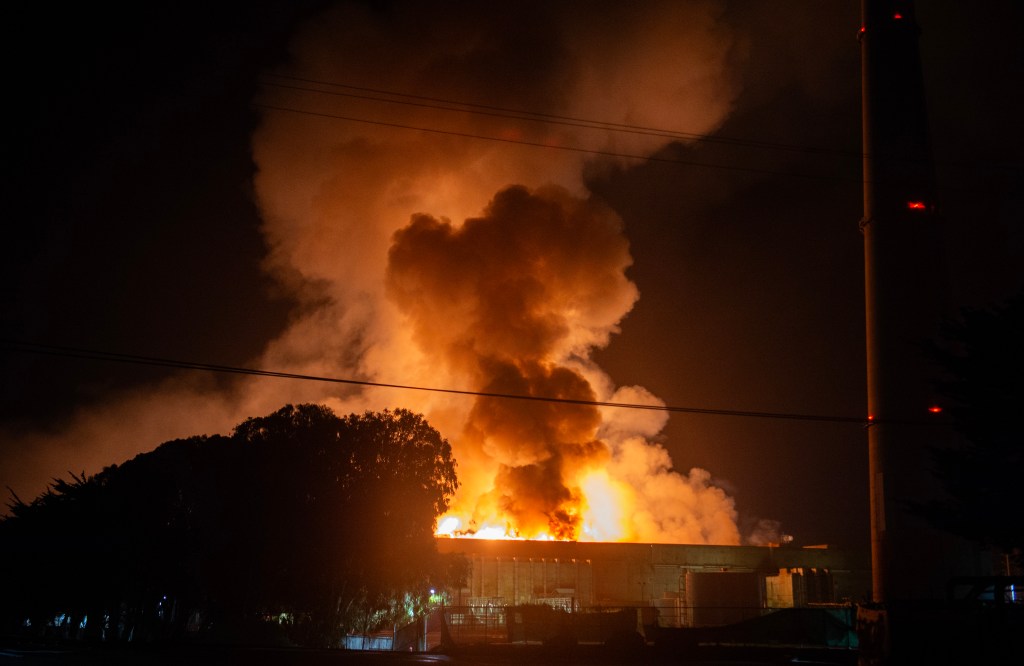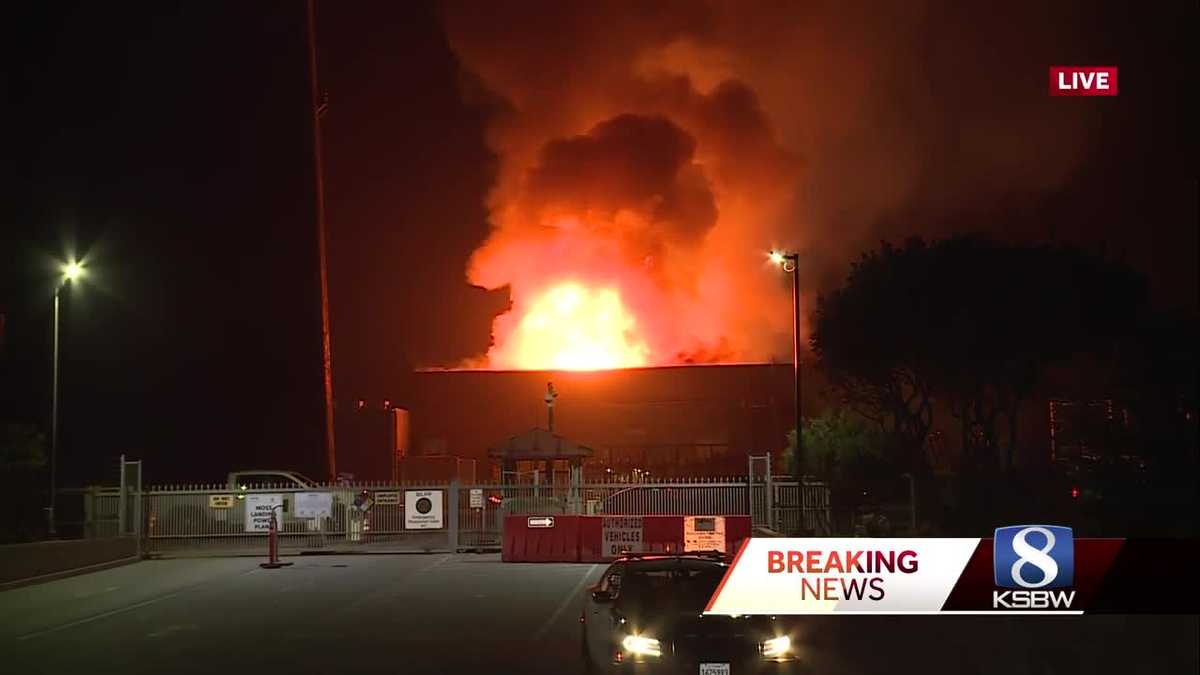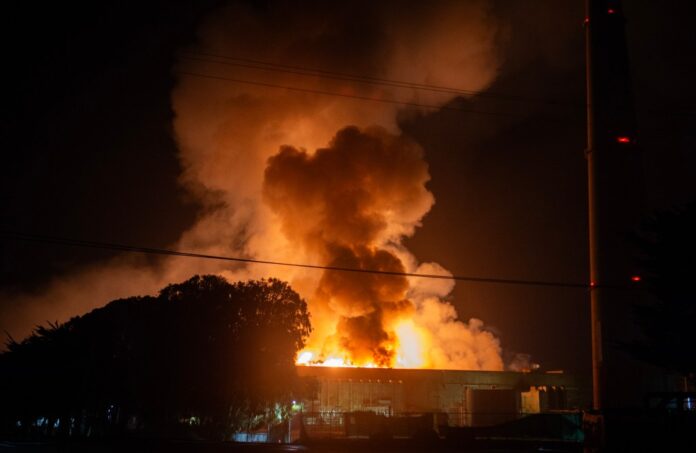BREAKING: Calamity Unfolds in Coastal California – ‘Devastating’ Fire Engulfs Moss Landing Battery Plant, Threatens Community

A massive inferno has erupted at the Moss Landing battery plant on California’s Central Coast, sending shockwaves of panic through the local community as toxic smoke billows into the air. The catastrophic fire, which has prompted evacuations and road closures, has left residents and officials scrambling to contain the situation and ensure public safety.

As we bring you the latest updates on this unfolding disaster, reports are emerging of the Moss Landing battery plant, a facility known for producing energy storage systems, engulfed in a massive blaze that has already raised concerns about the potential environmental impact. The fire has also sparked fear among local residents, with authorities urging those in the surrounding areas to take immediate action and seek shelter.
The Devastating Battery Plant Fire in Moss Landing
Initial Fire Breakout and Evacuation Order
A massive fire broke out at a battery storage plant in Moss Landing, California, prompting evacuations and road closures. The incident was reported on Thursday afternoon, with the fire raging out of control and sending up huge flames and clouds of hazardous black smoke. The fire was detected at approximately 3 p.m. at the plant, located on Highway 1 in northern Monterey County.
As the fire spread, evacuations were ordered for areas of Moss Landing south of Elkhorn Slough, north of Molera Road and Monterey Dunes Way, and west of Castroville Boulevard and Elkhorn Road to the ocean. Approximately 1,500 people were affected by the evacuation order, with authorities urging residents to heed the warning and seek shelter in a safe location.
The Monterey County Sheriff’s Office called in additional agencies to assist with the emergency response, with all available resources in the county and surrounding jurisdictions deployed to assist with the incident.
Emergency Response and Coordination
The emergency response to the fire was led by the Monterey County Sheriff’s Office, with support from the North Monterey County Fire Protection District and other local agencies. The incident was characterized as a “major incident,” with multiple agencies working together to contain the fire and ensure public safety.
The facility, owned by Vistra Energy, is one of the largest battery storage plants in the world, holding tens of thousands of lithium batteries used to store electricity from solar power and other sources. The plant’s size and complexity presented unique challenges for the emergency responders, who had to contend with the difficult-to-extinguish lithium battery fires.
Community Impact and Evacuation Efforts
The community’s reaction to the fire was one of shock and concern, with many residents expressing fear for their safety. The evacuations were carried out in a swift and orderly manner, with authorities working to ensure the public’s safety and minimize disruptions to the surrounding area.
The fire had a significant impact on the local community, with many residents forced to leave their homes and seek shelter elsewhere. The incident highlighted the importance of emergency preparedness and evacuation procedures, with authorities emphasizing the need for residents to stay informed and follow instructions during such incidents.
The Battery Plant: A Key Player in California’s Renewable Energy Efforts
The Moss Landing Battery Plant’s Significance
The Moss Landing battery plant, owned by Vistra Energy, is a crucial component of California’s efforts to shift its electricity generation to renewable sources. The plant’s size and capacity make it one of the largest battery storage facilities in the world, with tens of thousands of lithium batteries used to store electricity from solar power and other sources.
The plant’s significance extends beyond its size, however. It represents a critical step in California’s transition to a renewable energy-based economy, with the state aiming to generate 60% of its electricity from renewable sources by 2030. The Moss Landing battery plant is a key player in this effort, providing a critical storage component for the state’s renewable energy infrastructure.
The Plant’s History and Expansion
The Moss Landing battery plant has a complex history, with multiple phases of development and expansion. The plant’s first phase was completed in 2020, with a capacity of 300 megawatts. However, in 2023, the plant underwent an expansion, increasing its capacity to 750 megawatts.
The plant’s expansion was a major undertaking, with multiple contractors and suppliers involved in the project. The expansion added significant capacity to the plant, making it one of the largest battery storage facilities in the world.
Lithium Battery Technology and Its Challenges
Lithium battery technology is a key component of the Moss Landing battery plant, with tens of thousands of lithium batteries used to store electricity from solar power and other sources. However, lithium battery fires are notoriously difficult to extinguish, presenting significant challenges for emergency responders.
The lithium battery fires are characterized by their high temperatures and toxic gases, which can cause respiratory problems, skin burns, and eye irritation. The difficulty in extinguishing these fires makes them particularly hazardous, requiring specialized equipment and training to respond effectively.
The Fire: Causes, Implications, and Lessons Learned
Investigating the Cause of the Fire
The investigation into the cause of the fire is ongoing, with multiple agencies working together to determine the root cause of the incident. The investigation will focus on identifying the source of the fire and determining whether any safety protocols or procedures were breached.
The investigation will also examine the plant’s safety record, including any previous fires or incidents. The findings of the investigation will be critical in determining the lessons learned from the incident and identifying areas for improvement.
Implications for Renewable Energy and Battery Storage
The fire has significant implications for the renewable energy sector, highlighting the need for improved safety protocols and procedures for battery storage facilities. The incident underscores the importance of emergency preparedness and response, with authorities emphasizing the need for residents to stay informed and follow instructions during such incidents.
The fire also raises questions about the long-term viability of lithium battery technology, with some experts suggesting that alternative technologies may be more suitable for large-scale energy storage applications.
Practical Lessons and Safety Measures
The fire has provided valuable lessons for the renewable energy sector, highlighting the need for improved safety protocols and procedures for battery storage facilities. The incident underscores the importance of regular maintenance, inspection, and testing to prevent similar incidents.
Authorities are emphasizing the need for enhanced emergency preparedness and response, with a focus on public education and awareness. The incident highlights the importance of community engagement and cooperation in promoting a safe and responsible renewable energy sector.
The Future of Battery Storage and Safety Measures
The Future of Renewable Energy and Battery Storage
The renewable energy sector is expected to continue growing in the coming years, with many experts predicting a significant increase in the adoption of battery storage technologies. However, the fire highlights the need for improved safety protocols and procedures to ensure the safe operation of these facilities.
The industry is expected to focus on developing more advanced safety features and protocols, including improved fire suppression systems and enhanced emergency response procedures.
Implementing Safety Measures and Preventing Future Fires
The fire highlights the need for improved safety measures and protocols to prevent similar incidents. Authorities are emphasizing the need for regular maintenance, inspection, and testing to ensure the safe operation of battery storage facilities.
The industry is expected to focus on developing more advanced safety features and protocols, including improved fire suppression systems and enhanced emergency response procedures.
Community Engagement and Education
The fire highlights the importance of community engagement and education in promoting a safe and responsible renewable energy sector. Authorities are emphasizing the need for public education and awareness, with a focus on emergency preparedness and response.
The community is expected to play a critical role in promoting a safe and responsible renewable energy sector, with a focus on cooperation and collaboration between industry stakeholders and local residents.
Conclusion
The massive fire at the Moss Landing battery plant, spewing toxic smoke and forcing widespread evacuations, serves as a stark reminder of the potential dangers associated with the rapid growth of renewable energy storage. While batteries are crucial for transitioning to a sustainable future, this incident highlights the need for rigorous safety protocols and stringent regulations within the industry.
The long-term implications of this fire are far-reaching. Beyond the immediate environmental concerns and potential health risks to those exposed to the smoke, this event could erode public trust in renewable energy technologies. It also raises critical questions about the preparedness of emergency responders and local communities to handle such large-scale incidents involving hazardous materials. As we continue to invest in a cleaner energy future, lessons learned from this tragedy must be swiftly implemented to ensure the safety and well-being of both people and our planet.
This isn’t just a setback for renewable energy, it’s a wake-up call. We must ensure that the pursuit of a sustainable future doesn’t come at the cost of our safety.
